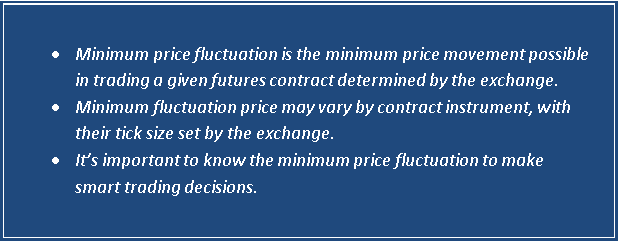What is Minimum price fluctuation?
Minimum price fluctuation, also referred as tick or point, is the minimum price movement possible in trading a given futures contract determined by the exchange and is standardised by the underlying product. It can also be defined as the fluctuation in the price of a security from one trade to another trade.
Minimum fluctuation price may vary by contract instrument, with their tick size set by the exchange. In the US market, increase in prices of a security is measured in percentage or dollar. However, currencies have a minimum price fluctuation in Pips, whereas stocks are traded in 1% minimum price fluctuation increment and rates in basis points. It’s important to know the minimum price fluctuation to make smart trading decisions. The rise in price of the security is indicated in the local currency associated with the market in which the security is listed.

How is Minimum Price Fluctuation determined?
In modern trading, minimum price fluctuation generally has a basis of decimals and investments may have different tick sizes depending on the market in which they participate. Until early 2000s, the tick size in US markets was determined on fractions of a dollar basis.
For most of the stocks, the fraction was 1/16, so the minimum price fluctuation determined US $0.0625, but some stocks had 1/8 and 1/32 fractions for low traded stocks and more liquid and active stocks, respectively.
The Fraction Minimum Price Fluctuation contract was first originated with the New York Stock Exchange (NYSE) that was build on Spanish trading system and used a base of eight or on various fingers on a person’s two hands, which is deducted from the thumbs since they aren’t considered fingers.
In 2005, the Securities and Exchange Commission (SEC) introduced Rule 612, under which the minimum price fluctuation for stocks over $1 needs was $0.01 and it can be listed in increments of US $0.0001. The Rule 612 is also known as Sub-Penny and this process was known as Decimalization.
Currently, the US Security and Exchange Commission (SEC) use minimum price fluctuation size of US $0.01 or 1% for most of the stocks. In futures market, the minimum price fluctuation size depends on the instrument, with minimum of US $1 also known as Points.
For example, the minimum price fluctuation size of the S&P 500 E-mini has minimum price fluctuation size of US $12.50 or 0.25, which means if the contract’s current price is US $2,453 and in case someone want of offer more, they can only bid at a minimum US $2.465.50, but the other futures index may move as minimum as US$10 and some US$5.
Why Minimum Price Fluctuation matters
All the assets such as Stocks, futures, options and other has a minimum price fluctuation and in case the investor do not have knowledge about the minimum price fluctuation of the future contract, they may knowingly take a trade position that is too high or low to trading objectives and expectations, as the price of each contract fluctuate a different amount, compared to other contracts.
How to know minimum fluctuation prices of future contracts
To find the minimum fluctuation price and value of different future contracts, visit the CME Group’s website, if the contract trades on CME Group. Then select markets on the website, then select featured products or category of products and chose a product and then select contract specs. The minimum price fluctuation and the value of dollar will be included in the basic future contract information.
Minimum Price Fluctuation as Movement Indicator
The minimum price fluctuation also used to indicate the direction of the price of a stock. An upward movement indicates that the trade took place at a price higher than the previous transaction and the downward movement indicates the trade took place in the price lower than the previous transaction.
The uptick rule was a trading restriction on short-selling when the contract price increases, to reduce downward pressure on a stock when it is already declining and it was abolished in 2007, by Security and Exchange Commission (SEC).
But, with the abolishment of uptick rule the financial crisis also started, making lawmakers to rethink on their decision. However, the SEC introduced a new rule, which restricted accumulation of stocks whose prices has fallen by over 10% in a day.
Determining profit and loss on minimum price movement
For example, if you purchased four contracts of the E-mini S&P future contracts at US $1,223.35 and its prices rise to US $1,224.35, investors will make profit of US $200 as the price rose by four ticks:
US $12.50 X 4 contract X 4 ticks = US $200
In case, the price of contract declined to US $1,220, investor may have lost US $650 as the price went down by 13 ticks:
US $12.50 X 4 contracts X 13 ticks = US $650
As stocks generally trade in 100-share units called lots for each percent of price movement, investor may make profit or loss of $1 on each lot.
 Please wait processing your request...
Please wait processing your request...